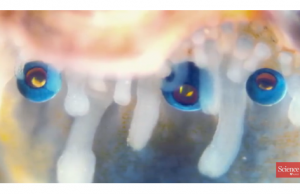Ocean creatures are known for their weird eyes, but scallops have one of the weirdest visual systems of all. These marine bivalves (above) have up to 200 eyes, and each of them uses a mirror instead of a lens to focus light. Biologists have known since the 1960s that these concave mirrors are made from crystals of guanine, a highly reflective material that can be seen in everything from fish scales to chameleon skin. Although these crystals usually form into bulky prisms, the crystals in the scallop’s eye are perfect squares that—like a telescope mirror—create a smooth surface that minimizes optical distortions. Now, scientists have shown just how these mirrors work. Using computer simulations, they found that when light comes in straight, it hits the upper of the scallop’s two retinas. But when light comes in at an angle, it hits the lower retina, enhancing the scallop’s peripheral vision in dim light, they report today in Science. They also hypothesize just how these creatures make sense of images from 200 different eyes at once: a process in the scallop’s “brain” that combines them all into a single, cohesive image.



















